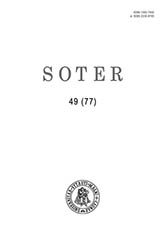Transfigūracijos proceso samprata krikščioniškos kilmės netradicinių religinių bendrijų doktrinose
Conception of the transfiguration process in the doctrines of non-traditional religious communities of Christian origin
Author(s): Dainius SobeckisSubject(s): Christian Theology and Religion
Published by: Vytauto Didžiojo Universitetas
Keywords: Transfigūracija; Perkeitimas; A. Maceina; P. Tillichas; Netradicinė religinė bendrija; Transfiguration; Transformation; A. Maceina; P. Tillich; Non-traditional religious community
Summary/Abstract: Straipsnyje analizuojama, kaip Lietuvoje XXI a. pradžioje egzistuojančios krikščioniškos kilmės netradicinės bendrijos supranta transfigūracijos procesą. Transfigūracijos esmė yra žemės perkeitimas, apie ką savo filosofijoje yra kalbėję A. Maceina ir P. Tillichas. Pristatoma pastarųjų autorių transfigūracijos samprata ir Kristaus perkeitimo koncepcija Naujajame Testamente. Transfigūracijos procesas, arba, kitaip sakant, perkeitimas, susideda iš pasaulio pabaigos, Paskutinio teismo, naujos žemės įsteigimo ir amžinybės. Visų transfigūracijos proceso dalių eiliškumas ir samprata įvairių krikščioniškos kilmės netradicinių bendrijų doktrinose skiriasi. Straipsnyje pristatoma adventistų, baptistų, branhamistų, Didesnės malonės atstovų, Išganymo armijos, Jehovos liudytojų, Kristaus Bažnyčios atstovų, laisvųjų krikščionių, metodistų, mormonų, sekmininkų bei Pilnos evangelijos judėjimo atstovų mokymai apie transfigūracijos procesą. Pateikiama netradicinių religinių bendrijų požiūrio į transfigūracijos procesą sisteminė analizė. A. Maceina states that all chronos time history consists of three events: 1) the creation of the world, 2) the redemption of the world and 3) the transformation of the world. The creation of the world is the beginning of its existence. The transformation of the world means the end of chronos time. The redemption of the world is a connecting link. The history of the world from its creation to the moment of its transformation systematically turns towards the transfiguration. Man’s creation comes through the culture and God’s intervention into the world order, or the transfiguration, is God’s final creation. A. Maceina and P. Tillich took a similar position in relation to the transfiguration. Both of them emphasized the present time between the Redemption of the world and its Resurrection. The Redemption of the world is directly linked to the Resurrection, Christ’s entry into kairos time and the transfiguration – with the second coming of Christ and the transformation of the world. There is a direct link between the transfiguration and kairos time. The conception of transfiguration in the consciousness of non-traditional Christian religiosity is quite different, although essential elements are common to many non-traditional religious communities. Some elements of the transfiguration are explicated by many non-traditional religious communities; however, other elements in some communities cannot find biblical support. The non-traditional Christian religious concept of transfiguration can be explicated into the following nine main elements. Predictions on the end of the world. Predictions on the end of the world can be treated as an introduction into the transfiguration process. The announcement of the end of the world presupposes the inevitability of the transfiguration process. Mentioned predictions are typical for Adventists, Branhamites and Jehovah’s Witnesses.
Journal: SOTER: religijos mokslo žurnalas
- Issue Year: 77/2014
- Issue No: 49
- Page Range: 127-138
- Page Count: 12
- Language: Lithuanian

